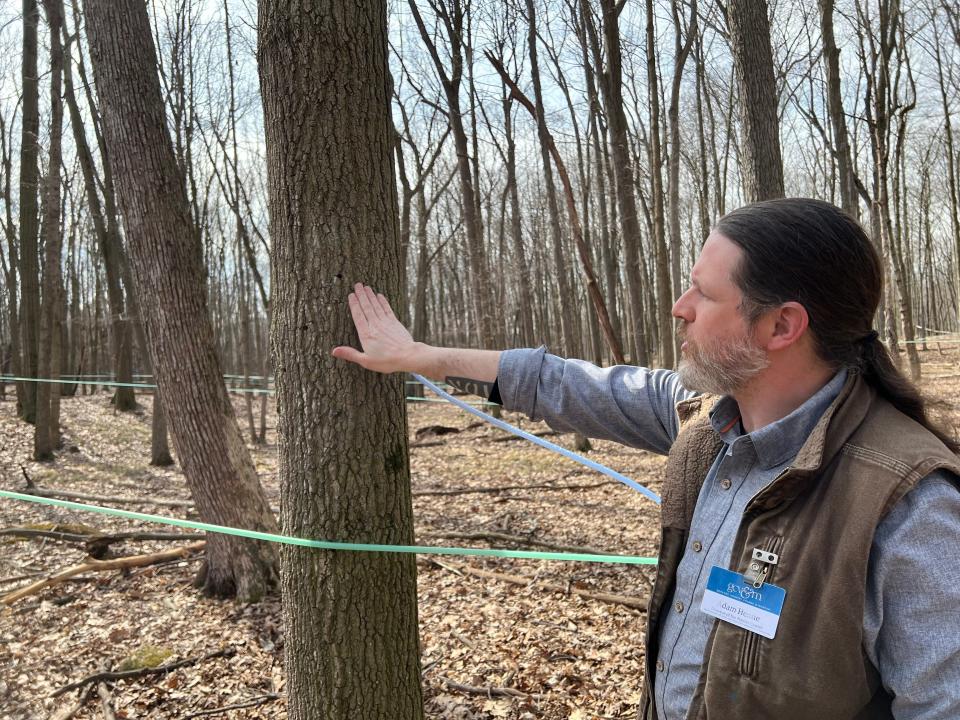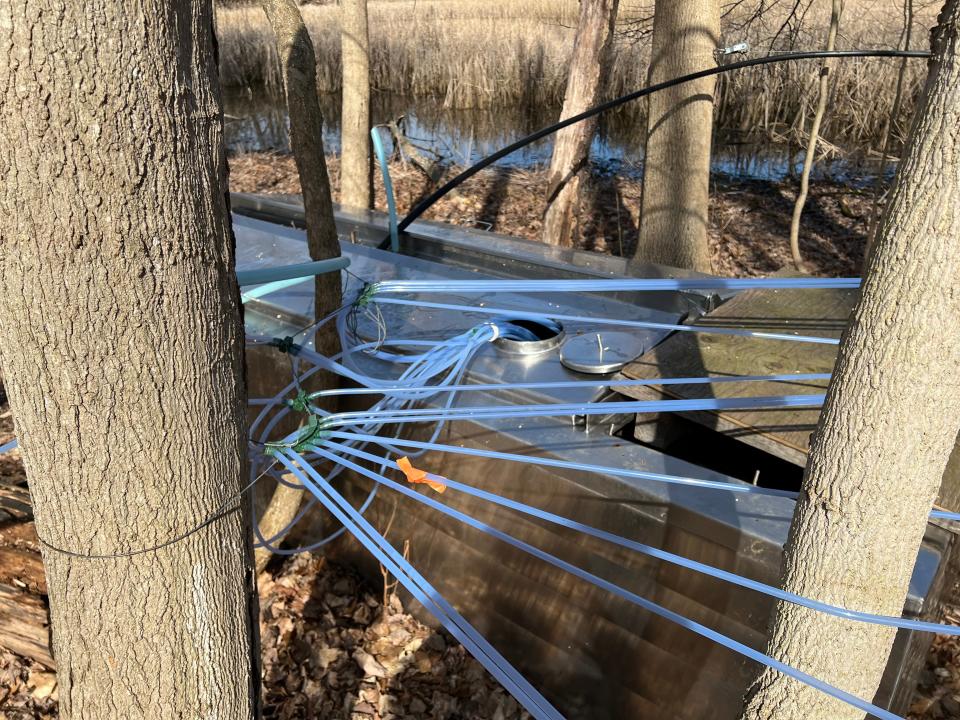Maple producers in Rochester are experiencing a below-average harvest. What's causing it?
There’s a common bit of advice that when you can hear spring peepers, it marks the end of the maple sugaring season.
At Kettle Ridge Farm in Victor they heard the high-pitched trill of the tiny frogs on March 14. Record-breaking warm temperatures in winter, followed by an exceptionally warm start to March, have created a shortened — and soon to end — maple season.
”It’s not good for maple sugaring because the warm weather is not going to help bring in the sap for the entire season,” said Joe Hurley, owner of Kettle Ridge Farm. “So the season gets shortened considerably in this type of weather.”
Maple syrup timing in New York
The ideal conditions to get the sweet sap from sugar maple trees flowing is 25 degrees at night and 45 degrees during the day, where the sap freezes at night and thaws during the day. There’s also a hard end point on the season, as the first buds on the tree indicate the sap will become unusable as syrup, with the tree’s sugar being used to grow leaves. This “buddy” sap tends to be cloudy and have an undesirable flavor.

Outside the sugar house at Genesee Country Village & Museum, a mature sugar maple tree serves as the bellwether for the end of the maple season. Adam Henne, director of the museum’s Nature Center, spied the beginning buds in the upper branches of the tree, marking an end to their sap collection efforts.
Henne said the center’s taps were put in the third week of January and they managed to harvest sap for about five weeks from the approximately 200 trees managed on the property.
How is NY maple syrup sap collected?
The sap is siphoned through feet of rubber tubing at a 2% downhill slope to gravity-fed collection tanks.
Maple trees are tapped about an inch and a half deep, so viable trees must be 10 inches in diameter and have a circumference greater than 18 inches. The trees are tapped in new locations each year, about three to four inches from the previous spot, allowing it to recover and heal.
Some local maple syrup producers started tapping trees near the beginning of January, Henne said; the traditional rule of thumb was to tap on Valentine’s Day. “That’s pretty early,” Henne said. “And it’s been getting consistently earlier for a few years, I gather.”
The weather plays an outsized role on whether or not there will be a good maple sap season. Last year, Kettle Ridge Farm had a record harvest with 500 gallons of syrup, but this year expects to get about half. Hurley said a strong March helped close out the season well in 2023, but that hasn’t been the case this year.
The collected sap is run through an evaporator to remove water content and create the thicker, sweeter syrup. The sugar content of sap varies from 1% to 4%; maple syrup is typically about two-thirds sugar.
How warm winter weather affects maple syrup production
Timing can be everything. Two years ago, there was an early thaw followed by cold and the Nature Center missed the timing, only getting about three weeks of sap, Henne said.
“It’s not like there’s a linear process where you can say, ‘Well, it’s getting warmer so our crop is declining,’” Henne said. “It’s that it gets more unpredictable when the days are warmer.”
Last year, Hurley tapped half of his trees early in the season and half late, which helped lead to the record-breaking harvest. The same technique didn’t yield results this year, with there being very little late-season weather to take advantage of.

Due to the unpredictable nature of the maple industry, some businesses like Kettle Ridge Farm are diversified well beyond its 1,200 taps. There’s an event venue, pancake breakfasts, food truck, on-site-produced honey and mead, and a bed and breakfast. A spinoff business is slated to open later this year in Perinton.
“I think it’s necessary, especially for smaller producers like ourselves,” Hurley said. “Because there probably aren’t enough maple trees in all of Victor to support the expenses of running this place.”
The Genesee Country Village and Museum’s Nature Center is an educational endeavor and therefore not focused on turning a profit, though the on-site maple syrup and sugar are sold in the gift shop.
More: Where to go maple sugaring around Rochester: Tours and festivals
More: Ice wine, maple syrup and more: How warmer winters affect New York specialties
Maple sugaring weekends in Rochester NY
Despite the challenges facing this season’s harvest, there are plenty of opportunities to partake in the two weekends of maple festivals.
The Genesee Country Village & Museum’s Maple Sugar Festival continues March 22, 23 and 24, with daily activities from 10 a.m. to 3 p.m. Highlights of the festival include a maple breakfast and look into the history behind maple syrup and maple sugar production, including Leon Briggs discussing Haudenosaunee sugaring traditions and techniques, as well as a 19th-century sugar camp. For details and tickets, visit gcv.org/event/maple-sugar-festival.
Maple Weekends at Kettle Ridge Farm continue March 23 and 24 from 9 a.m. to 2 p.m. each day. Enjoy live demonstrations in the sugar house, a maple breakfast and KettleJuice, a maple grapefruit IPA as part of a yearly collaboration with Noble Shepherd Craft Brewery. Learn more at kettleridgefarm.com/maple-weekend.
RMSC Cumming Nature Center will continue its 46th annual Maple Sugaring Weekends on March 23 and 24. Visitors can enjoy a locally-sourced breakfast of pancakes and sausage with real maple syrup and admission to a quarter-mile maple sugaring trail demonstration to learn about the process to make the sweet local treat.
— Steve Howe covers weather, climate and lake issues for the Democrat and Chronicle and prefers pancakes to waffles. A graduate of Rochester Institute of Technology, Steve has covered a wide variety of topics at newspapers in upstate New York and Utah. Have any insight into changing weather or climate? Share with him at showe@gannett.com.
This article originally appeared on Rochester Democrat and Chronicle: New York maple syrup production down during warm winter in 2024

